| Version française |
Scorpion FV101 CVRT
Light reconnaissance 76mm cannon tracked armored vehicle - United Kingdom
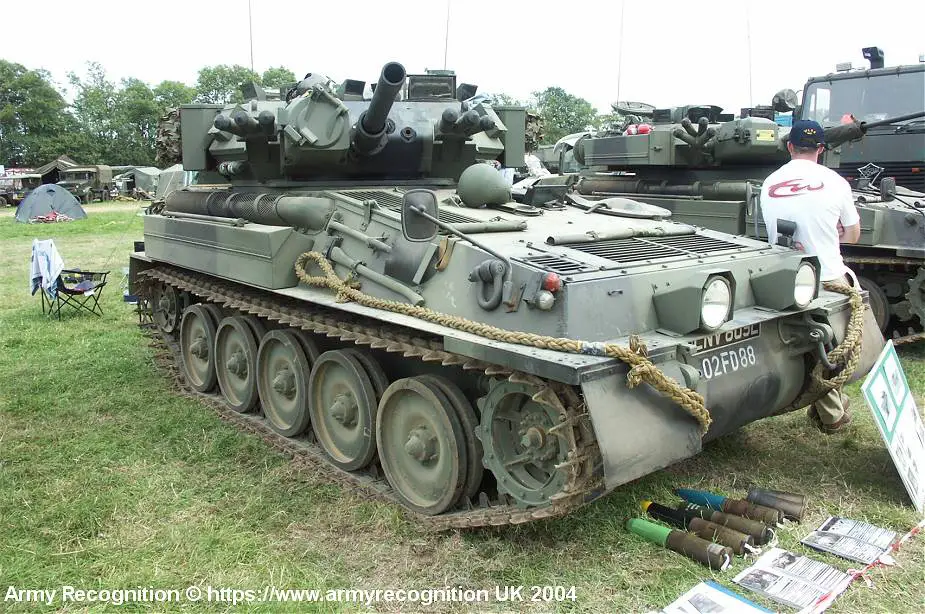
Description
The FV101 Scorpion is a British light tank and reconnaissance vehicle that played a significant role in the history of armored warfare. Its development began in the late 1960s, and it entered service in the mid-1970s. The Scorpion was designed to fulfill a need for a fast and mobile reconnaissance vehicle with sufficient firepower to engage and destroy lightly armored enemy vehicles. The FV101 Scorpion is part of the Combat Vehicle Reconnaissance (Tracked) or CVR(T) family, which is a series of light armored reconnaissance vehicles designed and built by Alvis Vehicles Ltd (now BAE Systems) in the United Kingdom. The CVR(T) family was developed in the late 1960s and 1970s and was designed to be lightweight, air-transportable, and versatile to meet the diverse requirements of the British Army. The development of the FV101 Scorpion can be traced back to the 1960s when the British Army identified a need for a new, fast reconnaissance vehicle capable of operating in various terrain conditions. The project was initiated by the British Ministry of Defence, which commissioned the Alvis Vehicles Ltd. (formerly Alvis Car and Engineering Company Ltd) to design and develop the new vehicle. The first prototype of the FV101 Scorpion was completed in 1969, and extensive trials were conducted to test its capabilities. It officially entered service with the British Army in 1973. The Scorpion was used by various countries, including Belgium, Iran, Jordan, Nigeria, Oman, the Philippines, Spain, and Venezuela. Throughout its service life, the FV101 Scorpion saw action in several conflicts, such as the Falklands War (1982) and the Gulf War (1991). The British Army retired the Scorpion in 1994, although it continued to serve in some foreign armies well into the 21st century. The Scorpion's legacy endures, as it set the standard for light tanks and reconnaissance vehicles in the modern era.
Scorpion FV101 CVRT variants:
- Scorpion 90: This variant of the Scorpion FV101 was upgraded with a new 90mm main gun, replacing the original 76mm gun.
- Scorpion 2: This variant was an upgraded version of the Scorpion FV101, which included improved armor protection, a new engine, and new communications equipment.
- Scorpion 3: This variant was a further development of the Scorpion 2, with upgraded night vision equipment, improved fire control systems, and enhanced mobility.
- Scorpion 4: This variant was a proposed upgrade to the Scorpion FV101, which would have included a new engine, improved armor protection, and enhanced sensors and communications equipment. However, this upgrade was never implemented.
Technical Data
| Armament |
|
The FV101 Scorpion features a fully rotating, two-man turret made of welded aluminum. The primary armament of the FV101 Scorpion is a 76mm L23A1 low-velocity gun, which is capable of firing a variety of ammunition types, including high-explosive (HE), high-explosive squash head (HESH), smoke, and canister rounds. The gun is intended for use against infantry, light vehicles, and fortifications. While not designed to engage heavily armored targets, the HESH rounds can still cause damage to less protected areas of enemy tanks. The turret's elevation and traverse capabilities are primarily manual; however, if needed, the vehicle can be equipped with a powered traverse system. The 76 mm gun offers an elevation range of +35º and a depression of -10º, while the turret can rotate a full 360º. The second armament of the Scorpion includes coaxial 7.62mm L37A2 machine gun, mounted to the left of the main gun. This machine gun provides additional firepower for engaging infantry and light vehicles. Each side of the turret is also equipped with four-barreled electrically operated smoke grenade dischargers which can be used to create a smoke screen for concealment and protection during withdrawal or maneuvering. The smoke grenades can be fired individually or in a rapid sequence to create a larger screen.
|
| Design and protection |
|
The FV101 Scorpion design consists of three main parts with the driver seated at the front left part of the hull, the powerpack at the front on the right, and the turret at the rear. The vehicle has a crew of three including the driver, commander and gunner who are seated in the all-welded aluminum armor turret with the commander on the left and the gunner on the right. The hull and the turret of the Scorpion are made of all-welded aluminum armor and provide the crew with protection against attack over its frontal area from 14.5 mm projectiles and against 7.62 mm armor-piercing rounds over the remainder of the vehicle. The aluminum armor also provides protection against artillery shell splinters.
|
| Mobility |
| The FV101 Scorpion is powered by a Jaguar J60 4.2-liter 6-cylinder petrol engine, which produces approximately 195 horsepower. The engine is coupled to a TN15 X-type transmission, which provides seven forward gears and one reverse gear. The combination of engine and transmission allows the Scorpion to efficiently utilize its power in various driving conditions. The Scorpion has a top speed of approximately 80 km/h on roads and is capable of maintaining good mobility off-road as well. It has a maximum cruising range of 640 km. The Scorpion features a torsion bar suspension system with five rubber-tired aluminum road wheels on each side with the drive sprocket at the front and the idler at the rear, providing a smooth and stable ride over rough terrain. The system also includes hydraulic shock absorbers and bump stops, which help to reduce the impact of obstacles and maintain the vehicle's stability during high-speed maneuvers. There are no track-return rollers. The Scorpion is able to negotiate side slopes of up to 30°, cross a trench of up to approximately 2 m wide, and climb vertical obstacles up to 0.5 m high. The FV101 Scorpion is not designed as an amphibious vehicle, and it does not have inherent swimming capabilities. However, it can be fitted with a flotation screen if required for limited amphibious operations, such as crossing small rivers or shallow water bodies. With the flotation screen installed, the Scorpion can propel itself through the water using its tracks, although its waterborne mobility is limited compared to purpose-built amphibious vehicles. |
| Combat Equipment |
| The FV101 Scorpion is equipped with a range of onboard equipment including a radio communication system, which allows the crew to maintain contact with other units and command elements during operations. The system may include VHF or HF radios, as well as an intercom for internal communication between crew members. The vehicle is also equipped with optical sights for both the commander and the gunner to observe the battlefield and engage targets. The sighting system may include day and night vision capabilities, as well as a laser rangefinder for accurate target distance measurement. Mounted to the right of the main armament is a now BAE Systems passive night sight with a magnification of ×5.8 (8º field of view) and a low magnification of ×1.6 (28º field of view). The Scorpion may be fitted with a Global Positioning System (GPS) or other navigation aids to help the crew determine their location and plan routes during missions. Additionally, the vehicle may be equipped with a compass and map storage for manual navigation if necessary. Standard equipment also includes an NBC protection system, which includes air filtration and overpressure systems to protect the crew from potential contamination during NBC incidents. The vehicle is typically fitted with an automatic fire suppression system to protect the crew and vehicle from potential fires caused by combat damage or mechanical failures. |
Specifications
| Armament | Armor |
| One 76 mm gun, one 7.62 mm machine gun, two banks of three grenades launcher | All-welded aluminum armor, protection against 14.5 mm caliber at the front, 7.62 mm hull 360° |
| Country users | Weight |
| Botswana, Brunei, Chile, Honduras, Iran, Indonesia, Ireland, Jordan, Malaysia, Nigeria, Oman, Philippines, Spain, Tanzania, Thailand, Togo, United Arab Emirates, and Venezuela. | 8,073 kg |
| Designer Country | Speed |
| United Kingdom | 80.5 km/hr maximum on road |
| Combat Equipment | Range |
| A fire control system, NBC system, night vision system | 644 km |
| Crew | Dimensions |
| 3 | Length: 4,80 m; Width: 2,23 m; Height: 2,10 m |
Details View
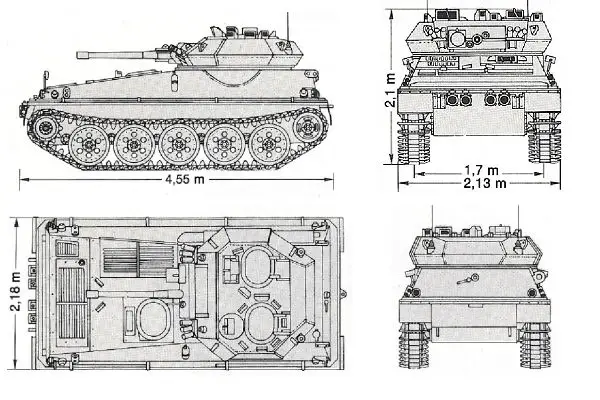 |
|
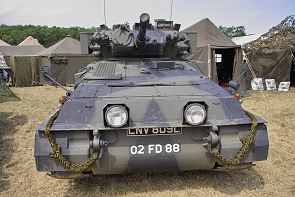 |
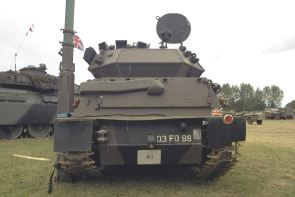 |
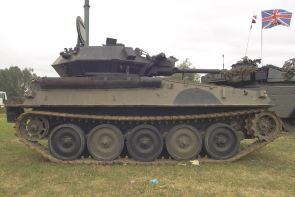 |
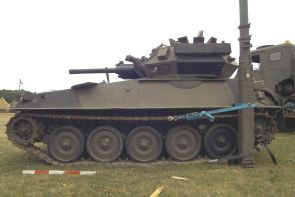 |
Pictures - Video















